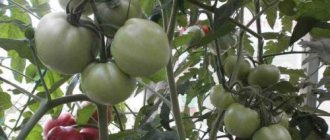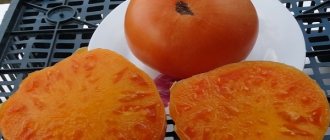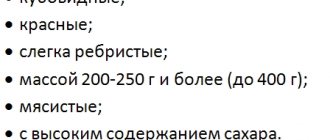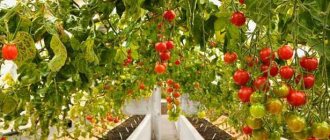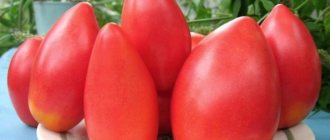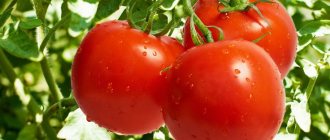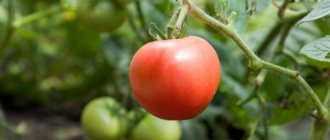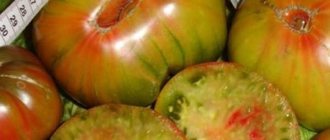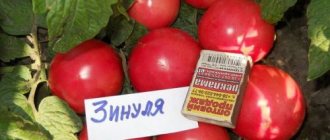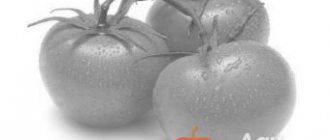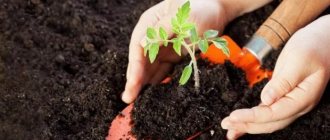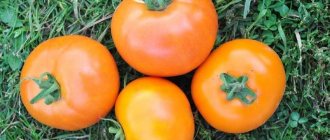Iceberg tomato is one of the few varieties that can grow successfully in open ground. It withstands unfavorable conditions in central Russia well. The fruits of this tomato have a good taste, beautiful shape and are great for homemade preparations and cooking.
| Height | Landing location | Ripening time | Fruit color | Fruit size | Origin | Fruit shape |
| short | Greenhouse, Open ground | Early ripening | Reds | Average | Variety | Round |
Main characteristics of fruits and their use
The fruits themselves grow quite large and heavy. They have a round shape and a sufficient number of seeds. The inner pulp is juicy and meaty. The fact that tomatoes are ready to be used in cooking is indicated by their bright red color.
Due to the many ripening fruits on the branches, the bushes may need to be tied to additional support. The reduced wateriness of the pulp allows the tomatoes to remain fresh for several days after harvest. They are well suited both for preparing fresh salads and as ingredients for tomato juice or ketchup. The thickness of the peel allows you to preserve tomatoes for the winter, preserving their integrity and balanced, pleasant taste. The characteristic meatiness of tomatoes makes them one of the most used dietary products when following a therapeutic diet.
Description of tomato
Iceberg tomatoes have a low bush system with strong stems. Just like branches, they support their own weight. If there are a large number of fruits, it is better to tie them to a support. The height of tomatoes does not exceed 80 cm.
The Iceberg tomato variety is a determinate plant. Due to the fact that height growth is limited, fruit ripening occurs faster.
Description of fruits
The fruit of the Iceberg variety is large and can grow up to 200 g. The tomato itself comes in two types: flat-round or bag-shaped, ribbed. The fruits are fleshy with a red tint. They have a low density and soft structure. The taste is sweet, the flesh is juicy. The tomato has a large number of seeds.
Advantages and disadvantages of the variety
The demand for this variety of tomatoes among active gardeners is primarily due to:
- high level of peel density and fleshiness of the pulp;
- lack of mandatory and timely pinching of stems;
- unpretentiousness to the environment and growing conditions;
- balanced sweet taste and characteristic rich aroma;
- resistance to sudden temperature changes;
- good tolerance to unexpected frosts and severe cold snaps.
Thanks to the last two features, this tomato variety is suitable for growing in areas with a short period of summer heat and long cool nights.
Among the disadvantages, it is worth highlighting the impossibility of obtaining a good harvest if the bushes are grown in a greenhouse or any other enclosed space. The second important point concerns the need for additional protection of bushes from possible damage by insects, as well as common diseases associated with the proliferation of fungi and microbes.
History of the appearance of the variety
Speaking about the emergence of the Flyashen tomato variety, it is necessary to begin with the fact that for the last several decades in the world there have been special varieties and hybrids of tomatoes with an elongated, pepper-shaped shape that have been actively developed by breeders. Tomatoes of this group have dense flesh and, due to the high dry matter content, are even hollow.
Comment! They are very convenient to use in cooking for preparing various sauces, since they do not require long evaporation, for drying, and for making stuffed dishes.
We recommend reading: Shorthaired Pointer is a hunting dog. Description, features, character, care and price of the breed. The article will tell you in detail about the shorthaired pointer breed, its characteristics, character and price.
Among them, the most famous are San Marzano, Eros, Auria and others.
In Germany, they even created a special name for this group of tomatoes - Flaschentomaten, which means bottle tomatoes. Indeed, many representatives of this group are very similar in shape to a bottle, since, in addition to the elongated shape, the fruits have a slight thinning (waist) approximately in the middle.
Already in the 21st century, the German breeder Valery Sonn, taking as a basis a tomato hybrid called Corianne F1 from the group of bottle tomatoes, made an attempt to develop a new variety, some plants of which had larger fruits and much higher yields than the original hybrid. After all, the tomatoes of the Corianne F1 hybrid looked more like cherry tomatoes, and were very small, reaching only 4-5 cm in length.
Attention! For some reason, he named the new variety with a name that coincided with the name of an entire group of tomatoes, that is, Flaschentomaten. And if this name of the variety is pronounced in the Russian manner, then you get the Flyashen tomato.
Since this variety was obtained quite recently, it has not yet fully established itself and in the resulting plants there may be some differences in the shape and size of the fruit, depending on the growing conditions.
The Flyashen tomato has not yet been included in the State Register of Russia, since, from a biological point of view, it is too early to call it a variety. He still has to go through many more tests in order for the plant characteristics to stabilize.
Recommendations for growing seedlings
Even before sowing seeds, it is recommended to thoroughly disinfect all containers and tools that will be used in the future. The boxes or plastic containers themselves must have holes at the bottom. This will allow for additional ventilation of the seed and the sprouts themselves, protecting them from the manifestation of blackleg disease. The room in which the seeds will germinate must have an air temperature of at least 15 degrees Celsius and a mandatory ventilation system. Slow and infrequent germination of seeds can also be caused by insufficient lighting and infrequent ventilation of the soil containers themselves. As a rule, the first shoots should appear within 7 to 10 days after sowing.
As for the soil for seeds, it can be universal soil, compost, or a special seeding substrate with a minimum level of acidity. If compost is used, it should consist of sand and peat in equal parts. It is better to sow seeds in rows, thanks to which each of the sprouts will receive maximum light and nutrients for further development. The distance between seeds should be at least 1.5 - 2 cm.
Before starting sowing, it is recommended to moisten the soil well, and the seeds themselves must be warmed up. If it is recommended to sow seeds at the end of March, then planting of formed bushes should be planned after 45 - 60 days (late May - early June).
Characteristics and features of growing Iceberg tomato
Iceberg tomatoes belong to the category of early plants that can be grown in open ground conditions and count on high yields. The bushes themselves are distinguished by the density of strong stems and small height, up to 80 cm.
The characteristic short stature and compactness allows you to use the plot more economically, obtaining ripe, tasty tomatoes weighing up to 200 grams. Thanks to this, you can get about 3.5 - 4 kg of harvest from one bush. The period of fruit growth and ripening takes about 85–95 days. You just need to figure out how to grow them correctly.
Features of planting in open ground
It is recommended to plant strong, dense stems with 5–6 leaves in open soil. In the process of covering the root system, abundant watering with warm water is necessary. Stepping is optional. More attention should be paid to sufficiently loosening the soil and supplying plants with moisture, especially during periods of prolonged drought. For a good harvest, it is recommended to rarely, but always abundantly water the root system of the bushes.
The fruits grow quite large and the fruiting period is quite long, so harvesting must be done regularly and carefully. You can count on the appearance of the first bright red fruits already in early July.
Transplanting
As soon as the plants get stronger, it is worth planting them in the garden. According to calendar dates, this should be done no earlier than May. By this time, the soil will have warmed up well, and the threat of frost will have completely passed.
Before planting, it is necessary to prepare the area. To do this, you need to dig it up, clear it of weeds, and apply fertilizer. Next, you should prepare the holes and carefully plant the plants.
To reap a good harvest, crops need to be looked after. Basic care is as follows:
- Watering. Tomatoes are considered moisture-loving crops. They need to be watered regularly and carefully. Watering must be done at the root, without getting on the leaf part.
- Weeding. Weeds slow down plant growth, so it is necessary to get rid of them in a timely manner. In addition, weeds can cause diseases and pests.
- Loosening the soil. The procedure is important; it allows you to get rid of the soil crust. As a result, air will flow to the root part.
- Feeding. During the season, fertilizing is required three times. For this, it is allowed to use organic and mineral compounds.
- Garter and stepson. Procedures are considered important. They allow you to improve the quality of the harvest and protect plants from unfavorable factors.
- Processing of crops. The Egyptian Rook tomato is resistant to many diseases. However, treating crops with chemicals will not be superfluous.
Note! To protect plants from diseases and pests, crop rotation should be strictly observed and all care activities should be carried out on time.
Typical pest hazards and common diseases
This variety of tomatoes most often requires additional protection of bushes from late blight, septoria and blossom end rot. If these diseases are detected, the bush must be completely removed from the area, since it is no longer possible to save it, and the infection can spread to other plants.
Timely protection must also be carried out against insect pests. This primarily concerns mole crickets, root-knot nematodes, wireworms and whiteflies.
If yellowing of the leaves is noticed in the bushes, and the fruits themselves become hard and stop growing, it means that the plants do not have enough nitrogen. A lack of phosphorus can be indicated by leaves curled inward.
Reviews
Reviews from gardeners about the Flyashen tomato are mostly not only positive, but also enthusiastic. Which, however, is not surprising, given the characteristics of this variety.
Larisa, 46 years old, Belgorod I accidentally got a few tomato seeds from Germany of the Flyashen variety. I tried so hard to grow them in an ideal way, but still they managed to get subject to return frosts when planted in the ground. She saved it, of course, by cutting off everything that was damaged, and they grew back as stepchildren, but we couldn’t expect real harvests from them. I will definitely try to grow them again, because even in such a half-crippled form, the tomatoes shocked me with their productivity. In addition, these tomatoes still keep very well. At the end of summer, they still managed to get caught in a hailstorm and even in a damaged state, with spots, they lay for about 3-4 weeks and looked absolutely as if they had just been picked from the garden. Valentina, 52 years old, Khakassia Flyashentomat’s tomatoes were very tasty, sweet, like natural candies. Dense in structure, ideal for all workpieces. But I didn’t like that I was severely affected by crown rot. Olga, 34 years old, Moscow region, also grew Flyashen tomatoes last season. The variety is very interesting; during last year’s short summer it managed to grow very good brushes. Of course, I grew it in a greenhouse and in warm beds fertilized with organic matter. But still, the bushes looked great. The top was in single copies, and did not affect the harvest in any way. Making sun-dried tomatoes from the fruits of this variety is a real pleasure. It's a pity, there were just very few seeds. Some of his stepchildren even decided to root them so as not to be left without these tomatoes next year.
We recommend reading: Manual milking
Landing rules
This variety is characterized by planting exclusively in the ground and only from seedlings, so you need to prepare for the summer season in advance. To do this, containers are prepared in the spring in which the first shoots will appear, and then full-fledged plants.
Iceberg tomatoes are not prone to disease, however, preventive measures will not hurt, so the containers are disinfected, the seeds are washed in a light solution of manganese, and special soil is used for seedlings. For the Iceberg variety, a universal substrate can be used to fill containers. If the gardener decides to mix it himself, it is worth taking the same amount of sand and peat.
Growing healthy and high-quality seedlings requires moisture and warmth, so it is best to cover the containers with the substrate and seeds with film.
Once the seedlings are ready for planting, you can move the plants to a permanent location. Considering that the Iceberg variety is low-growing and compact, it is allowed to place up to 7 bushes per 1 m². At the same time, they must be formed in order to get a good harvest.
Next, all that remains is to water the plants well. In addition, Iceberg tomatoes are very fond of fertilizing, so they should be applied regularly, preferably 2 times a month until the first ripe fruits appear.
